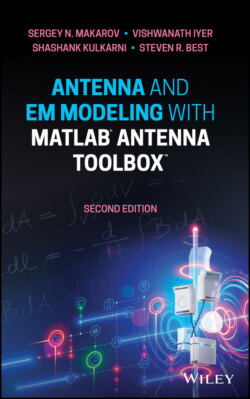Читать книгу Antenna and EM Modeling with MATLAB Antenna Toolbox - Sergey N. Makarov - Страница 21
Example 1.4
ОглавлениеFor a half‐wave long patch antenna on a lossy dielectric substrate, the ratio of two resistances, RL/Rr, is approximately given by [1]
(1.11)
where h is the patch antenna thickness, W is the patch antenna width, λ0 = c0/f is the wavelength in free space at frequency f in Hz, εr is the relative dielectric constant of the substrate, and tan δ is the loss tangent of the substrate. Determine the antenna efficiency if f = 930 MHz, W = 7 cm, and the substrate is a low‐cost 62 mil FR4 with εr=4.2 and tanδ=0.02.
Solution: A simple MATLAB script given below programs Eq. (1.11) and outputs RL/Rr = 3.62 and E = 0.22 or 22%. This result is remarkably discouraging; it says that 78% of power supplied to the matched antenna is lost in the antenna substrate itself whereas only 22% of the supplied power is really radiated! Better dielectric substrates with lower loss (and typically of higher cost) must be used at higher frequencies in order to reduce power loss to an acceptable level.
clear all; epsilon = 8.85418782e-012; % Diel. perm. vacuum, F/m mu = 1.25663706e-006; % Magn. perm. vacuum, H/m c = 1/sqrt(epsilon*mu); % Speed of light vacuum, m/s h = 62/1000*2.54e-2; % Patch antenna thickness, m W = 0.07; % Patch antenna width, m eps_r = 4.2; % Rel. diel. constant, FR4 tand = 0.02; % Loss tangent, FR4 f = 930e6; % Frequency, Hz lambda0 = c/f; % Wavelength in vacuum Ratio = 3/32*sqrt(eps_r)*lambda0^2*tand/(h*W) E = 1/(1 + Ratio)
